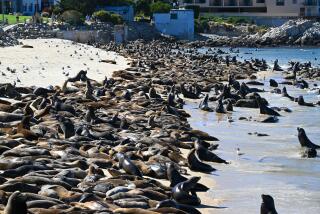A Tern for the Better
- Share via
There’s something incongruous about the proprietors of a site devoted to weapons of mass destruction welcoming bird lovers to their property. It’s to the credit of the U.S. Navy on one side and civilian bird monitors on the other that an accommodation has been found at the Seal Beach Naval Weapons Station.
The facility has an island where least terns nest. The lovely white birds are threatened less by the weapons that are loaded aboard naval ships than by their enemies in nature: feral cats, possums and other animals.
It’s not much of a trick sometimes for the predators to get past the electric fence surrounding Nasa Island. That’s where the volunteers come in.
When they spot an animal bent on raiding the nest of a least tern on the island, they create noise. Some volunteers use soda cans full of rocks; others bang pots and pans; some blow whistles.
About 50 people have volunteered for the four-hour shifts; last year 140 nests produced about 200 chicks. That was a marked improvement over 1999, when all the eggs and chicks and many adult birds were eaten, according to the co-chairman of the Friends of the Seal Beach National Wildlife Refuge.
The terns once were abundant in the skies over California, but development took away nesting spots and their numbers dropped greatly. In 1970 the California subspecies of the bird was deemed endangered. By then, only about 600 pairs were left in the state. After the concerted effort to stem the decline, the number of pairs is estimated to be nearly 3,000.
Federal officials have designated six sites in Los Angeles and Orange counties as protected breeding areas. The birds winter in Central and South America but return north to breed. Volunteer monitors say a problem with the designated sites is that they are so small that nests are clustered together. In more natural conditions they would be spread out, creating more difficult targets for predators.
Development has reduced habitat for birds and animals in Orange County. The realization that some species may be imperiled has spurred efforts intended to increase the number of least terns. It’s important to maintain that vigilance and take steps to reduce the impact of new homes and businesses.
More to Read
Sign up for Essential California
The most important California stories and recommendations in your inbox every morning.
You may occasionally receive promotional content from the Los Angeles Times.













